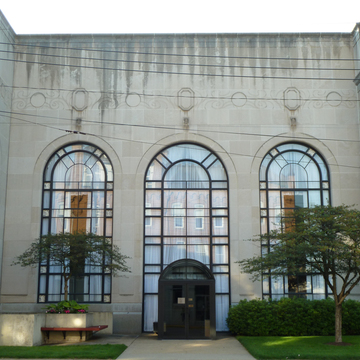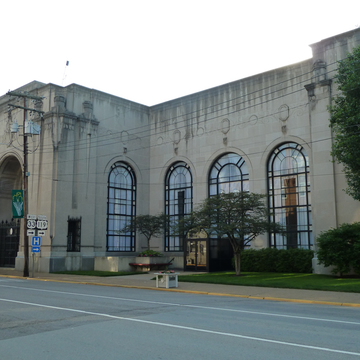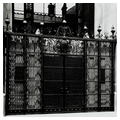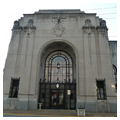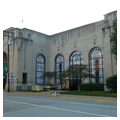Weston's second major architectural attraction has received accolades ever since it opened. West Virginia historian Roy Bird Cook, whose article in the September 1930 issue of The West Virginia Review provided a full description, called it “an architectural gem,” and the tribute still applies. Designed by an architect from Allentown, Pennsylvania, it is built of Indiana limestone above a gray granite foundation. Although the originally rectangular block is 50 feet high, the equivalent of five stories, it reads architecturally as one. A deeply recessed, paneled arch at the center of the facade is topped successively with a carved shield, the head of a Roman legionnaire, and a stylized eagle with outspread wings. On line with the shield, a band of rinceau ornament, containing a series of roundels, swirls, and small circles, serves as a frieze that continues around the building. At ground level, a wrought iron gate, which contains an oval ceramic panel with the seal of West Virginia as its centerpiece, protects the entrance. Master craftsman Samuel Yellin fabricated this and all the ironwork, which is used extensively both outside and in.
The richly appointed main banking room, which occupies most of the interior, is filled with examples of Yellin's ironwork in tellers' cages, lighting fixtures, and hardware. Walls are paneled with burled walnut to a height of 11 feet and plastered above. The cornice displays molded relief figures, and the ceiling is highlighted with a huge plaster relief map of West Virginia, in the center of which the great seal of the state is superimposed. These are highlighted with muted silver and gold leaf. A 1980s addition, which extends at a right angle from the north side of the building, doubles the space of the banking room. Original features have been relocated where necessary and reused. In all respects, the new work honors and emulates the scale and decorative treatment established in 1930.
Samuel Yellin (1885–1940) thought of himself as a blacksmith, or at least referred to himself as one. Born in Poland, he came to Philadelphia in 1906 and enrolled as a student in metalwork at the School of Industrial Art, sponsored by the Philadelphia Museum of Art. He soon took charge of the forge and taught for several years before establishing an independent practice. His ornamental wrought iron embellishes New York's Cathedral of St. John the Divine, the National Cathedral in Washington, and numerous estates along Philadelphia's Main Line. His work at Weston is an interesting and little-known chapter in his oeuvre.



